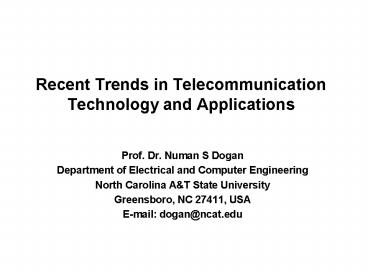Recent Trends in Telecommunication Technology and Applications PowerPoint PPT Presentation
1 / 48
Title: Recent Trends in Telecommunication Technology and Applications
1
Recent Trends in Telecommunication Technology and
Applications
- Prof. Dr. Numan S Dogan
- Department of Electrical and Computer Engineering
- North Carolina AT State University
- Greensboro, NC 27411, USA
- E-mail dogan_at_ncat.edu
2
Outline
- The Spectrum Challenge and Technology Development
- Smart Antennas
- Software Defined Radio (SDR) and Cognitive Radio
(CR) - Spectrum Management and Flexible Use Rights
- Radio System Basics and Electrospace
- Command-and-control
- Electrospace rules
- My recent transceivers work
- SOI CMOS receiver (funded by NASA)
- Medical Implant Communication System (MICS)
Transceiver (funded by WIMS-University of
Michigan, NSF ERC)
3
(No Transcript)
4
(No Transcript)
5
(No Transcript)
6
(No Transcript)
7
(No Transcript)
8
(No Transcript)
9
(No Transcript)
10
(No Transcript)
11
(No Transcript)
12
(No Transcript)
13
(No Transcript)
14
(No Transcript)
15
(No Transcript)
16
(No Transcript)
17
Spectrum Management
- Spectrum management is the process of arranging
the use of the spectrum for communications and
sensing. - Who gets to use spectrum?
- For what functions?
- Under what restrictions?
- What are the processes to decide?
18
Radio System Basics-1
- Radio systems have
- Transmitter (including transmitting ant)
- Propagation path
- Receiver (including receiving antenna)
- Communications
- move data from transmitter to receiver
- Sensing
- Compare received signal with transmitted signal
to study path (radars, sensors, etc.)
19
Radio System Basics - 2
- The Electrospace describes the appearance of
radio signals transmitters propagation. - A receiver processes the electrospace to receive
communications. - One major goal of frequency management is to
arrange the signals in the electrospace so that
the desired signal can be separated out by a
simple and inexpensive receiver.
20
The Electrospace
- Electrospace (described by Hinchman in1969) is a
7-variable description of EM field strength
(hyperspace). - Physical location lat., long., altitude
3-dim - Frequency MHz 1-dim
- Time - µS, hours, or years
1-dim - Direction-of-arrival azimuth, elevation
2-dim - Electrospace describes radio signals, as they
appear from an ideal receiver at the physical
location. Note receiver includes receiving
antennas
21
Spatial Dimensions
- Any spatial region microcell to BTA, modify with
directional antennas. Caution some areas cannot
be used well coverage affected by terrain and
buildings, height above ground. Match spatial to
coverage.
22
Frequency Dimension
- The frequency dimension is well behaved and
intuitive, with a frequency band often divided up
into many identical non-overlapping channels.
23
Time Dimension
- FCC recently mentioned time as one additional
dimension that they would allow users to divide. - Months seasonal uses
- Hours to broadcast special football game
- Hours midnight-to-5am daily to send low cost
computer updates. - 10 ms TDMA timeslots every 50 ms.
- Useful for serving many intermittent activities.
24
Angle-of-Arrival Dimension
25
The Electrospace
26
Same spectrum, more users
27
Radio Systems
28
Interference - 1
29
Interference - 2
30
Interference 3
31
Better Receivers
32
Receiver standards?
33
Map of Spectrum Rights
34
Command and Control
35
In favor of CC
36
Problems with CC
37
Flexible Spectrum Use Rights
38
Electrospace Rules
39
Possible Downsides - 1
40
Possible Downsides - 2
41
Flexible-Use Summary
42
Low-Power SOI CMOS Receiver
- Project Overview
43
Low-Power SOI CMOS Receiver
Low-IF Receiver
44
Low-Power SOI CMOS Receiver
- Microphotograph of the Low-IF Receiver
45
Low-Power Medical Implant Communication System
(MICS) Transceiver
Huseyin S SAVCI, Zheng WANG, William BOWEN,
Ahamadou TANKO, and Dr. Numan S. DOGAN
North Carolina AT State University
46
System Description
- Implant Unit
- Listens for a transmitted signal from P/C Unit.
- Receives signals from P/C Unit (i.e. incoming
audio signals in Cochlear implant) and processes
data. - Transmits data/control parameters (i.e.
swallowable camera capsule)
- Programmer/Controller Unit (P/C)
- Monitors environment, determines the least noisy
channel available. - Establishes communication session over the
selected channel.
47
Targeted Specs for Implant Unit
Variable transmit and receive data rates for
different MICS applications. (Receiving audio
signal for Cochlear Implants, transmitting video
images for Endoscopic Camera Capsules)
48
Transceiver Architecture

